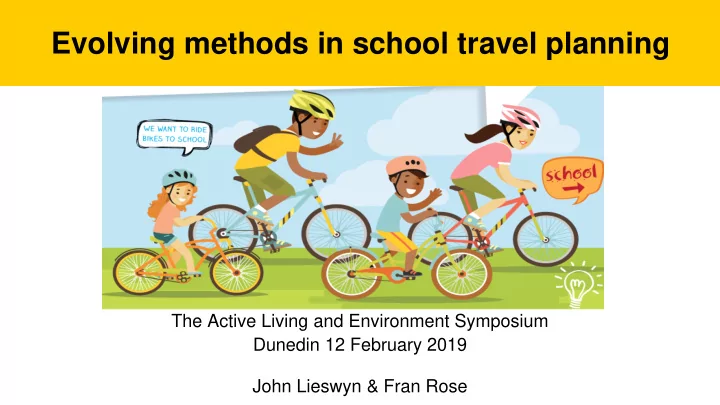

Evolving methods in school travel planning The Active Living and Environment Symposium Dunedin 12 February 2019 John Lieswyn & Fran Rose
Context: travel to school (NZ) MoT Household Travel Survey
Photo: Axa.co.uk
Making the case Sauter, D 2011 Walking the Social Space
Benefits of Active Travel • Health : active travel leads to better physical fitness and cardiovascular health STUDENTS • Safety : active travel are statistically safe ways to travel [1]. Cycling on the road is far safer than horseback riding, skiing, and rugby [2]. Learning traffic skills and encouraging group travel leads to ‘safety in numbers’ [3] • Learning : active travel is positively related to academic performance [4] and concentration [5] • Confidence : enhanced independence and confidence about getting around in the neighbourhood [6] COMMUNITY • Safety : cooperation can halve the number of crashes [7] • Cohesion : parents, teachers and neighbours get involved and put “eyes on the street” SCHOOL • Fewer discipline problems as students arrive alert and “ready to learn” • Less congestion at the school gate, freeing up space for those students who cannot use active transport 1. Larouche, R., et al., Associations between active school transport and physical activity, body composition, and cardiovascular fitness: a systematic review of 68 studies. J Phys Act Health, 2014. 11 (1): p. 206-27. 2. Ministry of Transport, 2015. Cyclist Crash Facts. 3. Chieng, M., H. Lai, and A. Woodward, How dangerous is cycling in New Zealand? Journal of Transport & Health, 2017. 4. Jacobsen, P., D. Ragland, and C. Komanoff, Safety in Numbers for walkers and bicyclists: exploring the mechanisms. Injury Prevention, 2015. 21 (4): p. 217-220. 5. Singh, A., et al., Physical activity and performance at school: a systematic review of the literature including a methodological quality assessment. Arch Pediatr Adolesc Med, 2012. 166 (1): p. 49-55. 6. Sauter, D., 2011, Walking the social space , in 5th World Congress of the Global Network Cities for Mobility : Stuttgart. 7. Auckland Transport. Safe school travel plans. Available from: https://at.govt.nz/cycling-walking/school-travel/travelwise-schools/safe-school-travel-plans/.
STP objectives • Collaborate on identifying problems, consequences, and potential solutions regarding: – Congestion at the school gate More students – Few students choosing active travel use active travel Active travel Active travel seems safer seems normal Fewer parents drive children to school How do we kickstart the ‘virtuous’ cycle?
US practice • Safe Ways to School coined in Florida in 1997 • SR2S legislated in California in 1999 • Safe Routes to School Partnership formed in 2005
Activities
Monitoring and reporting is required
So how do we do it in NZ?
Example 1: iWay & MoveIt
iWay pamphlets
Example 2: Whakatāne • 7 schools • Questionnaire (n=451) • Interactive mapping • Travel mode and origin mapping • School environs and site audits
Whakatāne audit recommendations School Council actions School actions ALL Public awareness campaign Bike parking upgrades Trident Red Conway Park paths Encouragement activities Goulstone Rd crossing, footpath renewals, Whakatāne High Remark carparks, east campus pathway Rex Morpeth Park barriers Salonika access path, church carpark access St Joseph’s Salonika footpath, King parking T’s policy, Bikes in Schools track Alexande & King St shared path; King / Replace bollards with more conspicuous type, Allandale Bridge St safety & access options mark kerb edges, radius driveway Staff travel plan / parking guidance, connection & Whakatāne Int. James St shared path, road markings, gate to Lagoon Path parking & bus stop review, Hinemoa St Student safety video, longer patrol coverage, shared paths & crossing operation review, James St staff travel plan / parking guidance, Warren Cole Lagoon path access, Henderson access McAlister crossing marking, Apanui Av bus Carpark lines, perpendicular carparks at main Apanui stop review, McGarvey Rd driveway upgrade, entrance, parent parking education Hikurangi//Tui greenway
Audit recommendations – all schools • Better bike parking • Rain = rust • UV = rubber failure • FixIt events
Activity recommendations Primary Intermediate High School Establish teacher, parent & student group to champion change and come up with their own solutions Supporting policies including driving rules (high school) and uniforms Walk n Roll to School Day(s) Walk n Roll to School Day(s) Pedometer challenge Walk & scoot safety training Bike Ready – skills for riding in Bikes in Schools & Junior Road Negotiate deals on stylish but Safety Park traffic practical adult bikes Seminar with celebrity role models Fix-A-Bike day each term Partnerships with Road Safety / Blue Light / Sport EBOP
Example 3: New Plymouth New Plymouth
Let’s Go results AbleyTransportation Consultants / NPDC
$7.5 : 1 Photo: WDC
Example 4: Dunedin Schools Cluster • Road safety & infrastructure focus • Phase 1 is lighter quicker cheaper – paint ’n posts • Phase 2 includes more permanent measures
Monitoring tools Whakatāne District Council AGOL
Resources – NZTA Education Portal • Integrates with curriculum • Can leverage access to NZTA funding https://education.nzta.govt.nz
Conclusions 1. Be flexible and be personable 2. Engage kids and parents 3. Measure and report
WINNERS
Recommend
More recommend